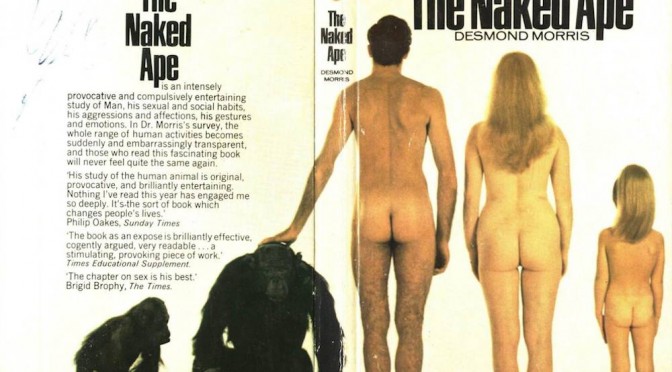The study Of Haplogroups ( see “Facts” above for information ) makes it possible to speculate on the history of the human race for the last 50,000 years.
What is revealed is astonishing. Based on a knowledge of the structure of DNA and the current distribution of Haplogroups throughout the world it is possible to speculate with reasonable confidence on massive movements of peoples. In all probability great conflicts resulted as one group of peoples replaced another. It gives edition visions of our remote past. But despite scientific overtones that his all it is no more than speculation. It is the opinion, often of a small community of specialists using a branch of science which is in itself in its early stages of development.
The study of DNA and in particular SNP’s inevitably requires the consideration of human behaviour and the planet we inhabit.
Mass Migrations
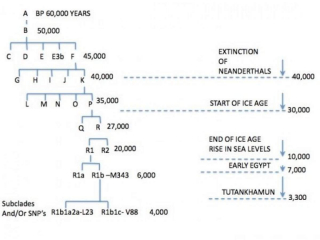 It is clear from consideration of the Haplagroup hierarchy and the present day distribution of Haplogroups that there have been mass migrations. Some of these migrations were undoubtably caused by climatic change, others by conflict and war. The record is incomplete and the study impeded by recent attempts to propose racial superiority using genetic arguments.
It is clear from consideration of the Haplagroup hierarchy and the present day distribution of Haplogroups that there have been mass migrations. Some of these migrations were undoubtably caused by climatic change, others by conflict and war. The record is incomplete and the study impeded by recent attempts to propose racial superiority using genetic arguments.
The distribution of haplogroups also gives evidence of human sexuality. Once again the study is flawed, perhaps under the influence of modern-day political correctness.
More about the Mating Game
 Ah! yes! I was beginning to speculate on the myriad of factors which underly natural selection and in particular the selection of partners.
To continue.
If a new elite, by invasion, migration or any other factor changed the genetic mix the haplogroup mix would inevitably change. But how?
If the new elite brought women with them this could the change the distribution of both Y and X Haplogroups.
However there have always been other factors at work. We do not have to go far back to discover that powerful men practiced poligamy and the number of children they were able to father and support was prodigious.
In contrast, in Atlantic communities there were quasi-matrilineal practices which meant that daughters never left their patents home. They received a string of suitors and chose the bravest and strongest as partners. This legislated in favour of a continually replenished gene pool.
As a general rule chastity coupled with parental control over the choice of partners tends to narrow the gene pool whereas liberality and multiple partners tends to widen the gene pool
In the days of political correctness, This was expressed succinctly by Desmond Morris in his book the Naked Ape. He postulated that human women have an in-built predilection for multiple partners. He theorised that women could not avoid this as their natural instinct was to ensure the widest possible gene pool offering the maxim potential for success in their own offspring.
A different argument is that powerful men have always been able to choose their partners on a basis of physical beauty rather than parentage, power or influence. Beauty seems to be independent of the sex determining chromosomes and is hidden away in one of the other twenty-two pairings. Minority Mt Haplagroups will therefore always survive. This should mean that will always be a wider spread of Mt Haplagroups than in the Y haplogroups in most geographical areas.
The total dominance of one particular Y Haplogroup or Mt Haplogroup can also be prevented by cultural, or religious differences which preclude the free selection of marriage partners.The distribution of Haplagroups depends on a myriad of factors which affect the choice of partners and therefore the underlying process natural selection. If a new elite, by invasion, migration or any other factor were to change the genetic mix then the haplogroup distribution would change with it. Not just the Y-haplogroups either. If the new elite brought women with them this would change the distribution of both Y and Mt Haplogroups.
Ah! yes! I was beginning to speculate on the myriad of factors which underly natural selection and in particular the selection of partners.
To continue.
If a new elite, by invasion, migration or any other factor changed the genetic mix the haplogroup mix would inevitably change. But how?
If the new elite brought women with them this could the change the distribution of both Y and X Haplogroups.
However there have always been other factors at work. We do not have to go far back to discover that powerful men practiced poligamy and the number of children they were able to father and support was prodigious.
In contrast, in Atlantic communities there were quasi-matrilineal practices which meant that daughters never left their patents home. They received a string of suitors and chose the bravest and strongest as partners. This legislated in favour of a continually replenished gene pool.
As a general rule chastity coupled with parental control over the choice of partners tends to narrow the gene pool whereas liberality and multiple partners tends to widen the gene pool
In the days of political correctness, This was expressed succinctly by Desmond Morris in his book the Naked Ape. He postulated that human women have an in-built predilection for multiple partners. He theorised that women could not avoid this as their natural instinct was to ensure the widest possible gene pool offering the maxim potential for success in their own offspring.
A different argument is that powerful men have always been able to choose their partners on a basis of physical beauty rather than parentage, power or influence. Beauty seems to be independent of the sex determining chromosomes and is hidden away in one of the other twenty-two pairings. Minority Mt Haplagroups will therefore always survive. This should mean that will always be a wider spread of Mt Haplagroups than in the Y haplogroups in most geographical areas.
The total dominance of one particular Y Haplogroup or Mt Haplogroup can also be prevented by cultural, or religious differences which preclude the free selection of marriage partners.The distribution of Haplagroups depends on a myriad of factors which affect the choice of partners and therefore the underlying process natural selection. If a new elite, by invasion, migration or any other factor were to change the genetic mix then the haplogroup distribution would change with it. Not just the Y-haplogroups either. If the new elite brought women with them this would change the distribution of both Y and Mt Haplogroups.
However there have always been other factors at work. We do not have to go far back in history to discover that powerful men practiced poligamy and the number of children they were able to father and support was prodigious. In contrast, in many Atlantic communities there were quasi-matrilineal practices which meant that daughters never left their parents home. They received a string of suitors and chose the bravest and strongest as partners. This legislated in favour of a continually replenished gene pool.
However, as a general rule chastity coupled with parental control over the choice of partners tends to narrow the gene pool whereas liberality and multiple partners tends to widen the gene pool.
Sociology or Zoology

Before the days of political correctness, these issues were expressed succinctly by Desmond Morris in his book the Naked Ape. He postulated that human women have an in-built predilection for multiple partners. He theorised that women could not avoid this as their natural instinct was to ensure the widest possible gene pool offering the maxim potential for success in their own offspring.
Before the days of political correctness, these issues were expressed succinctly by Desmond Morris in his book the Naked Ape. He postulated that human women have an in-built predilection for multiple partners. He theorised that women could not avoid this as their natural instinct was to ensure the widest possible gene pool offering the maxim potential for success in their own offspring.
A different argument is that powerful men have always been able to choose their partners on a basis of physical beauty rather than parentage, power or influence. Beauty seems to be independent of the sex determining chromosomes and is hidden away in one of the other twenty-two pairings. Minority Mt Haplagroups will therefore always survive. This should mean that there will always be a wider spread of Mt Haplagroups than in the Y haplogroups in most geographical areas.
The total dominance of one particular Y Haplogroup or Mt Haplogroup can also be prevented or encouraged by cultural, ethnical or religious differences which preclude the free selection of marriage partners.
Differentiation by Artefacts
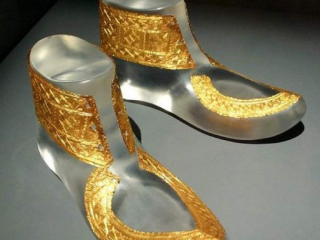 Traditionally investigations of various tribes or peoples has concentrated on archeological discoveries which in themselves lead to the identification of specific cultures, such as the "Hallstadt" or "La Tene" cultures, often defined by styles of building, burial, jewellery or domestic utensils.
This illustration has been chosen as I think it gives a totally different perspective on who the “ la Tene” people were. These are not “shoes” they are 'foot decoration'. Incredibly they have something in common with our images of Egypt.
Language is also considered important. Identification of language spoken and the group of languages the language belongs to can used to define "race". It is for this reason that the somewhat academic identification of the Ino european language grouping got mixed up with Hitler's Ayrian master race and the continuing fascination with white supremacy.
On the other hand a lot of the genetic work currently being carried out in India is both racially and politically inspired. The may not recognise it in these terms but they want to establish Indian racial supremacy and deny that any Ayrian "invasion" of India every took place. They don't believe the Indo euopean language came to india but that india was the source of both language and civilisation for the rest of the world and particularly Western Europe.
As the Indian experience shows, more recently DNA studies have come to the fore. The combination of DNA studies and the investigation of haplogroup distribution in regions and countries throughout the world has presented evidence of extensive migrations. These migrations may not have been invasions as such but just a gradual expansion of peoples with identifiable gene configurations into new territories. However each SNP mutations identified is considered to have happened once, in one individual, so the spread of the peoples carrying that mutation into territories already inhabited by other human beings will have inevitably have lead to some ancient wars, unrecorded except for dreamlike memories in ancient fables.Traditionally investigations of various tribes or peoples and the differentiation between peoples has concentrated on archeological discoveries which in themselves lead to the identification of specific cultures, such as the “Hallstadt” or “La Tene” cultures, often defined by differing styles of building, burial, jewellery or domestic utensils.
Traditionally investigations of various tribes or peoples has concentrated on archeological discoveries which in themselves lead to the identification of specific cultures, such as the "Hallstadt" or "La Tene" cultures, often defined by styles of building, burial, jewellery or domestic utensils.
This illustration has been chosen as I think it gives a totally different perspective on who the “ la Tene” people were. These are not “shoes” they are 'foot decoration'. Incredibly they have something in common with our images of Egypt.
Language is also considered important. Identification of language spoken and the group of languages the language belongs to can used to define "race". It is for this reason that the somewhat academic identification of the Ino european language grouping got mixed up with Hitler's Ayrian master race and the continuing fascination with white supremacy.
On the other hand a lot of the genetic work currently being carried out in India is both racially and politically inspired. The may not recognise it in these terms but they want to establish Indian racial supremacy and deny that any Ayrian "invasion" of India every took place. They don't believe the Indo euopean language came to india but that india was the source of both language and civilisation for the rest of the world and particularly Western Europe.
As the Indian experience shows, more recently DNA studies have come to the fore. The combination of DNA studies and the investigation of haplogroup distribution in regions and countries throughout the world has presented evidence of extensive migrations. These migrations may not have been invasions as such but just a gradual expansion of peoples with identifiable gene configurations into new territories. However each SNP mutations identified is considered to have happened once, in one individual, so the spread of the peoples carrying that mutation into territories already inhabited by other human beings will have inevitably have lead to some ancient wars, unrecorded except for dreamlike memories in ancient fables.Traditionally investigations of various tribes or peoples and the differentiation between peoples has concentrated on archeological discoveries which in themselves lead to the identification of specific cultures, such as the “Hallstadt” or “La Tene” cultures, often defined by differing styles of building, burial, jewellery or domestic utensils.
There is evidence however of some selectivity with regard to the artefacts chosen to illustrate the achievements or level of sophistication of the cultures studied. The “golden shoes” discovered on one of the “la Tene” sites gives a totally different perspective on who the “ la Tene” people were to the image projected by the more common displays of “la Tene” artefacts.
These are not “shoes” they are ‘foot decoration’. Interestingly in view of the Tutankhamun controversy they have something in common with images of Egypt.
Differentiation by Language
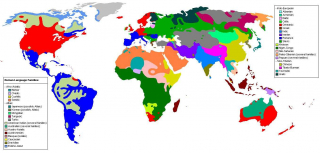 Language is also considered important. Identification of language spoken and the group of languages the language belongs to can used to define “race”. It is for this reason that the somewhat academic identification of the Inbo-European language grouping got mixed up with Hitler’s Ayrian master race and the continuing fascination with white supremacy.
Language is also considered important. Identification of language spoken and the group of languages the language belongs to can used to define “race”. It is for this reason that the somewhat academic identification of the Inbo-European language grouping got mixed up with Hitler’s Ayrian master race and the continuing fascination with white supremacy.
Hitler’s theories required an Arian invasion of India in order to explain the similarities between Sanscrit and the European languages and then a reverse migration back to Europe.
On the other hand a lot of the genetic work currently being carried out in India is both racially and politically inspired but in a totally different way. The Indian Scholars may not recognise it in these terms but there is in India a desire to establish Indian racial supremacy and deny that any Ayrian “invasion” of India every took place. They don’t believe the Indo_European language came to India but that India was the source of both language and civilisation for the rest of the world and particularly Western Europe.
Fact or Opinion?
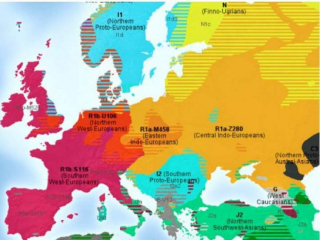 This diagram and the accompanying text was initially included under “facts” .
The diagram works in partial confirmation of the diagram in "facts" revealing the distribution of Haplagroup R1. It also shows the most prevalent sub clades on a geographical basis.
It has been "demoted" to opinion because the information it contains is the subject of considerable discussion and some disagreement amongst core geneticists. Bear in mind that my decision to demote is, in itself, only opinion,As the Indian researchers show, the combination of DNA studies and the investigation of Haplogroup distribution in regions and countries throughout the world has presented evidence of extensive migrations. These migrations may not have been invasions as such but just a gradual expansion of peoples with identifiable gene configurations into new territories.
This diagram and the accompanying text was initially included under “facts” .
The diagram works in partial confirmation of the diagram in "facts" revealing the distribution of Haplagroup R1. It also shows the most prevalent sub clades on a geographical basis.
It has been "demoted" to opinion because the information it contains is the subject of considerable discussion and some disagreement amongst core geneticists. Bear in mind that my decision to demote is, in itself, only opinion,As the Indian researchers show, the combination of DNA studies and the investigation of Haplogroup distribution in regions and countries throughout the world has presented evidence of extensive migrations. These migrations may not have been invasions as such but just a gradual expansion of peoples with identifiable gene configurations into new territories.
Nevertheless the spread of the peoples carrying that mutation into territories already inhabited by other human beings will have inevitably have lead to some ancient wars, unrecorded except for dreamlike memories in ancient fables.
Many of the diagrams used to illustrate the geographic distributions of Haplogroups contain extrapolations from limited data sets. They may therefore be considered to be more opinion than fact. One diagram attempts to show all the sub clades of R1 expressed in terms of their geographical dominance.
It must be considered opinion because the information it contains is the subject of considerable discussion and some disagreement amongst core geneticists. Bear in mind that the decision to consider this diagram opinion rather than fact, is, in itself, only opinion.
Stability of SNP’s
 This diagram showing the distribution of sub clades tells a more complex story.
The building of this structure depends on the fact that each SNP occurs once and only once in a single individual and will not reverse. Each mutation is isolated to a small part of the DNA and therefore the portion which existed pre mutation can still be detected. Well at least that what I was told last week. However I now hear mutterings emerging from private chat rooms that SNP’s will from now on be only be accepted if they are “stable”. To me this means that some proposed SNP’s have shown themselves capable of reversal! This could challenge some of the assumptions made.
There is an inherent Hierarchical structure in the "long names" for SNP's which is completely lost if only the "short" names are used.
R1b1c (or v88) the North African or “Berber” mutation is a close relation but a totally separate branch to R1b1a2 (M269) which has been identified as Tutankhamun’s DNA.
All the European mutations of R1b are subclades of Tutankhamuns R1b1a2.
The master sub clade for Western Europe R1b1a2a1a1 (L11) is a the third mutation from the DNA possessed by Tutankhamun and whoever shared it with him in Egypt. R1b1a2a1 (L150) and R1b1a2a1a (L51) precede it.
It is uncertain wether these mutations and L11 itself occurred in Europe or somewhere else. The favoured location for all three is being Anatolia /Armenia.
L11 then migrated in two different ways, firstly to the Pyrenees (Basque country) and from there north to Western France and the British Isles and secondly and Quite separately overland to the Swiss/German borders.
The L11 in the basque country then mutated into S116 which expanded into Spain and North Africa. S116 then produced Z196 and M193
L11 in Central Europe mutated into U106, underopinning the Halstatt, and possibly possibly La Tene cultures.
In the British Isles L11 mutated into the Atlantic Modal Haplotype (AMH) which until recently was described only by current observable STR’ s but which is apparently now being defined it terms of SNP mutationsin work not yet published.
Did you like all that! It is a hotbed of controversy and scientific argument.
What there is little disagreement about is that one of R1b's mutants emerged fron Anatolia ( modern Turkey) and travelled to Spain, North Africa, Western France, Brittany and the British isles through the Pyrenees.
The problem is that it apparently left behind in the Pyrenees a people who did not speak an Indo- European language. Hierarchical trees showing the development of mutations, particularly when they are shown against an estimated timescale must also be considered opinion.
This diagram showing the distribution of sub clades tells a more complex story.
The building of this structure depends on the fact that each SNP occurs once and only once in a single individual and will not reverse. Each mutation is isolated to a small part of the DNA and therefore the portion which existed pre mutation can still be detected. Well at least that what I was told last week. However I now hear mutterings emerging from private chat rooms that SNP’s will from now on be only be accepted if they are “stable”. To me this means that some proposed SNP’s have shown themselves capable of reversal! This could challenge some of the assumptions made.
There is an inherent Hierarchical structure in the "long names" for SNP's which is completely lost if only the "short" names are used.
R1b1c (or v88) the North African or “Berber” mutation is a close relation but a totally separate branch to R1b1a2 (M269) which has been identified as Tutankhamun’s DNA.
All the European mutations of R1b are subclades of Tutankhamuns R1b1a2.
The master sub clade for Western Europe R1b1a2a1a1 (L11) is a the third mutation from the DNA possessed by Tutankhamun and whoever shared it with him in Egypt. R1b1a2a1 (L150) and R1b1a2a1a (L51) precede it.
It is uncertain wether these mutations and L11 itself occurred in Europe or somewhere else. The favoured location for all three is being Anatolia /Armenia.
L11 then migrated in two different ways, firstly to the Pyrenees (Basque country) and from there north to Western France and the British Isles and secondly and Quite separately overland to the Swiss/German borders.
The L11 in the basque country then mutated into S116 which expanded into Spain and North Africa. S116 then produced Z196 and M193
L11 in Central Europe mutated into U106, underopinning the Halstatt, and possibly possibly La Tene cultures.
In the British Isles L11 mutated into the Atlantic Modal Haplotype (AMH) which until recently was described only by current observable STR’ s but which is apparently now being defined it terms of SNP mutationsin work not yet published.
Did you like all that! It is a hotbed of controversy and scientific argument.
What there is little disagreement about is that one of R1b's mutants emerged fron Anatolia ( modern Turkey) and travelled to Spain, North Africa, Western France, Brittany and the British isles through the Pyrenees.
The problem is that it apparently left behind in the Pyrenees a people who did not speak an Indo- European language. Hierarchical trees showing the development of mutations, particularly when they are shown against an estimated timescale must also be considered opinion.
The building of the Haplogroup hierarchy is firmly founded on the fact that each SNP occurs once in a single individual and will not reverse. Each mutation is isolated to a small part of the DNA and therefore the portion which existed pre-mutation can still be detected. Well… at least that what I was told last week. However I now hear mutterings emerging from private chatrooms that SNP’s will from now on be only be accepted if they are “stable”. To me this means that some proposed SNP’s have shown themselves capable of reversal! This could dramatically challenge some of the assumptions made.
